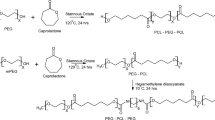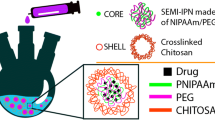Abstract
Methadone hydrochloride is a narcotic drug used to relieve chronic pain and control withdrawal symptoms in people undergoing detoxification for opiate addiction, but poses some limits. To reduce the limits and increase the drug’s effectiveness, supramolecular hydrogels composed of α-CD (α-cyclodextrin) and PCL/PEG (polycaprolactone/polyethylene glycol) copolymers, which gained attention due to their advantages, were chosen in this study as controlled-release formulations. PCL/PEG/PCL and PCL/PEG copolymers were synthesized by a microwave-assisted method and then supramolecular hydrogels were prepared by mixing the solutions of copolymers/drug and α-CD to make a methadone hydrochloride sustained-release system. Effects of the drug, copolymer, and α-CD concentrations and copolymer structure on gelation time were also investigated. The systems had rheological properties that depended on copolymer construction and component concentrations. The microwave-assisted method provides an accelerated synthesis of the copolymers with yield of 57 % and low level of impurities. The supramolecular hydrogels demonstrated shear thinning and thixotropic behavior and regained their networks quickly after passing through a fine needle. Due to the porous construction of supramolecular hydrogels, they swell in the presence of fluids and absorb large quantities of water, thereby making the system comprehensively biocompatible. In this study, supramolecular hydrogels composed of α-CD with tri- and di-block copolymers were investigated and found to have rheological properties that depended on copolymer construction and component concentrations. Changing one parameter alone like copolymer or α-CD concentration or the length of blocks could not significantly affect on the drug release, but combination of these factors was efficient. Results of the present study indicated that supramolecular hydrogels composed of α-CD and PCL/PEG copolymers are appropriate drug delivery systems that can release methadone hydrochloride in a sustained manner.











Similar content being viewed by others
References
Khodaverdi E, Rajabi O, Farhadi F, Jalali A, Mirzazadeh-Tekei FS (2010) Preparation and investigation of poly (N-isopropylacrylamide-acrylamide) membranes in temperature responsive drug delivery. Iran J Basic Med Sci 13:102–110
Dinarvand R, Khodaverdi E, Atyabi F (2005) Temperature-sensitive permeation of methimazole through cyano-biphenyl liquid crystals embedded in cellulose nitrate membranes. Mol Cryst Liq Cryst 442:19–30
Khodaverdi E, Tafaghodi M, Ganji F, Abnous K, Naghizadeh H (2012) In vitro insulin release from thermosensitive chitosan hydrogel. AAPS PharmSciTech 13:460–466
He B, Zeng J, Nie Y, Ji L, Wang R, Li Y, Wu Y, Li L, Wang G, Luo X, Zhang Z, Gu Z (2009) In situ gelation of supramolecular hydrogel for anti-tumor drug delivery. Macromol Biosci 9:1169–1175
Tabassi SAS, Mirzazadeh-Tekie FS, Hadizadeh F, Rashid R, Khodaverdi E, Mohajeri SA (2014) Sustained release drug delivery using supramolecular hydrogels of the triblock copolymer PCL–PEG–PCL and a-cyclodextrin. J Sol-Gel Sci Technol 69:166–171
Ma D, Zhang HB, Chen DH, Zhang LM (2011) Novel supramolecular gelation route to in situ entrapment and sustained delivery of plasmid DNA. J Colloid Interface Sci 364:566–573
Liu Y, Chan-Park MB (2009) Hydrogel based on interpenetrating polymer networks of dextran and gelatin for vascular tissue engineering. Biomaterials 30:196–207
Li J, Loh XJ (2008) Cyclodextrin-based supramolecular architectures: Syntheses, structures, and applications for drug and gene delivery. Adv Drug Deliv Rev 60:1000–1017
Zhao S, Lee J, Xu W (2009) Supramolecular hydrogels formed from biodegradable ternary COS-g-PCL-b-MPEG copolymer with α-cyclodextrin and their drug release. Carbohydr Res 344:2201–2208
Yin H, Gong C, Shi S, Liu X, Wei Y, Qian Z (2010) Toxicity evaluation of biodegradable and thermosensitive PEG-PCL-PEG hydrogel as a potential in situ sustained ophthalmic drug delivery system. J Biomed Mater Res B Appl Biomater 92 B:129–137
Zhou Y, Fan X, Xue D, Xing J, Kong J (2013) Thermosensitive supramolecular hydrogels from atom transfer radical polymerization of polypseudorotaxanes self-assembled by triblock copolymer and α-cyclodextrins. React Funct Polym 73:508–517
Harada A, Kawaguchi Y (1997) Complex formation of poly (ε-caprolactone) with cyclodextrin. Macromol Rapid Commun 18:535–539
Ko DY, Shinde UP, Yeon B, Jeong B (2013) Recent progress of in situ formed gels for biomedical applications. Prog Polym Sci 38:672–701
Gong C, Shi S, Wu L, Guo M, Yin Q, Guo Q, Dong P, Ahang F, Luo F, Zhao X, Wei Y, Qian Z (2009) Biodegradable in situ gel-forming controlled drug delivery system based on thermosensitive PCL–PEG–PCL hydrogel. Part 2: sol–gel–sol transition and drug delivery behavior. Acta Biomater 5:3358–3370
Gong CY, Shi S, Dong PW, Yang B, Qi XR, Guo G, Gu YC, Zhao X, Wei YQ, Qian ZY (2009) Biodegradable in situ gel-forming controlled drug delivery system based on thermosensitive PCL–PEG–PCL hydrogel: Part 1—synthesis, characterization, and acute toxicity evaluation. J Pharm Sci 98:4684–4694
Ahmed F, Discher DE (2004) Self-porating polymersomes of PEG–PLA and PEG–PCL: hydrolysis-triggered controlled release vesicles. J Control Release 96:37–53
Rhodes DJ, Grossman SA (1997) Hydromorphone polymer implant. A potential alternative to methadone maintenance. J Subst Abuse Treat 14:535–542
Negrín CM, Delgado A, Llabrés M, Evora C (2004) Methadone implants for methadone maintenance treatment. In vitro and in vivo animal studies. J Control Release 95:413–421
Khodaverdi E, Golmohammadian A, Mohajeri SA, Zohuri G, MirzazadehTekie FS, Hadizadeh F (2012) Biodegradable in situ gel-forming controlled drug delivery system based on thermosensitive poly(ε-caprolactone)-poly(ethylene glycol)-poly(ε-caprolactone) hydrogel. ISRN Pharm 2012:1–7. doi:10.5402/2012/976879
Khodaverdi E, Akbari A, Tekie FS, Mohajeri SA, Zohuri G, Hadizadeh F (2013) Sustained delivery of amphotericin B and vancomycin hydrochloride by an injectable thermogelling tri-block copolymer. PDA J Pharm Sci Technol 67:135–145
Khodaverdi E, MirzazadehTekie FS, Mohajeri SA, Ganji F, Zohuri G, Hadizadeh F (2012) Preparation and investigation of sustained drug delivery systems using an injectable, thermosensitive, in situ forming hydrogel composed of PLGA–PEG–PLGA. AAPS Pharm Sci Tech 13:590–600
Higashi T, Hirayama F, Misumi S, Arima H, Uekama K (2008) Design and evaluation of polypseudorotaxanes of pegylated insulin with cyclodextrins as sustained release system. Biomaterials 29:866–3871
Khodaverdi E, Hadizadeh F, Mirzazadeh-Tekie FS, Jalali A, Mohajeri SA, Ganji F (2012) Preparation and analysis of a sustained drug delivery system by PLGA–PEG–PLGA triblock copolymers. Polym Bull 69:429–438
Furness JF, Weekes A, Clench M, Wolf K, Barnes I, Hay AWM, Cooke M (1994) The determination of methadone and metabolites in human urine by HPLC with ultraviolet, and particle-beam mass-spectrometric detection. J Liq Chromatogr 17:4431–4444
Pillay V, Fassihi R (1998) Evaluation and comparison of dissolution data derived from different modified release dosage forms: an alternative method. J Control Release 55:45–55
Costa P, Manuel J, Lobo S (2001) Modeling and comparison of dissolution profiles. Eur J Pharm Sci 13:123–133
Ma MG, Jia N, Li SM, Sun RC (2011) Nanocomposites of cellulose/carbonated hydroxyapatite by microwave-assisted fabrication in ionic liquid: characterization and thermal stability. Iran Polym J 20:413–421
Gong C, Shi S, Dong P, Kan B, Gou M, Wang X, Li X, Luo F, Zhao X, Wei Y, Qian Z (2009) Synthesis and characterization of PEG-PCL-PEG thermosensitive hydrogel. Int J Pharm 365:89–99
Li J, Ni X, Leong KW (2003) Injectable drug-delivery systems based on supramolecular hydrogels formed by poly(ethylene oxide)s and α-cyclodextrin. J Biomed Mater Res A 65:196–202
Li X, Li J (2008) Supramolecular hydrogels based on inclusion complexation between poly(ethylene oxide)-b-poly (ε-caprolactone) diblock copolymer and α-cyclodextrin and their controlled release property. J Biomed Mater Res A 86:1055–1061
Zhao SP, Zhang LM, Ma D (2006) Supramolecular hydrogels induced rapidly by inclusion complexation of poly(ε-caprolactone)–poly(ethylene glycol)–poly(ε-caprolactone) block copolymers with α-cyclodextrin in aqueous solutions. J Phys Chem B 110:12225–12229
Zhao SP, Feng ZG, Piao DX (2003) Synthesis and characterization of photopolymerized supramolecular-structured hydrogels of alpha-CD assemblies. Chem J Chin 24:186–188
Qiao M, Chen D, Ma X, Liu Y (2005) Injectable biodegradable temperature-responsive PLGA-PEG-PLGA copolymers: Synthesis and effect of copolymer composition on the drug release from the copolymer-based hydrogels. Int J Pharm 294:103–112
Wu N, Wang LS, Tan DC, Moochhala SM, Yang YY (2005) Mathematical modeling and in vitro study of controlled drug release via a highly swellable and dissoluble polymer matrix: polyethylene oxide with high molecular weights. J Control Release 102:569–581
Glover AL, Nikles SM, Nikles JA, Brazel CS, Nikles DE (2012) Polymer micelles with crystalline cores for thermally triggered release. Langmuir 28:10653–10660
Ma D, Zhang LM, Xie X, Liu T, Xie MQ (2011) Tunable supramolecular hydrogel for in situ encapsulation and sustained release of bioactive lysozyme. J Colloid Interface Sci 359:399–406
Acknowledgments
This work was Pharm.D thesis of Maryam Aboumaashzadeh and was financially supported by grants from Mashhad University of Medical Sciences.
Conflict of interest
The authors confirm that there are no conflicts of interest.
Author information
Authors and Affiliations
Corresponding author
Rights and permissions
About this article
Cite this article
Khodaverdi, E., Aboumaashzadeh, M., Tekie, F.S.M. et al. Sustained drug release using supramolecular hydrogels composed of cyclodextrin inclusion complexes with PCL/PEG multiple block copolymers. Iran Polym J 23, 707–716 (2014). https://doi.org/10.1007/s13726-014-0265-4
Received:
Accepted:
Published:
Issue Date:
DOI: https://doi.org/10.1007/s13726-014-0265-4




